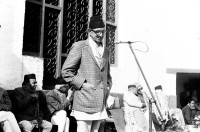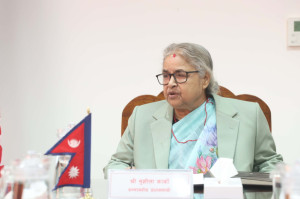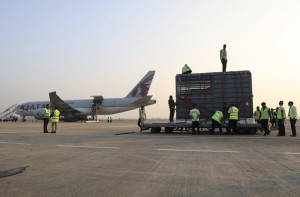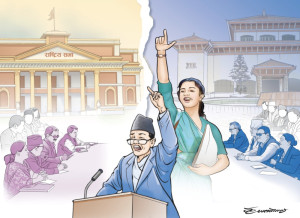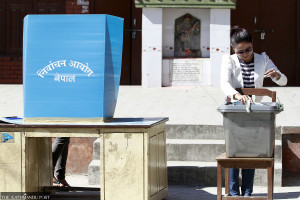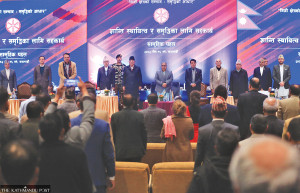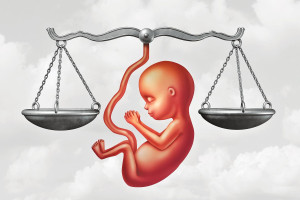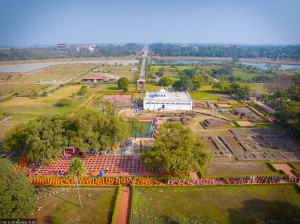Columns
Teachers’ agitation and metamorphosis
Neither the government nor the teachers can treat education as a matter of convenience.
Abhi Subedi
The turmoil created by the agitated teachers in Kathmandu over the month of April has metamorphosed the perceptions of many people who are directly or indirectly associated with teaching. As someone who has spent over half a century teaching at the tertiary level, the demonstration of teachers who teach over 5 million students in 29,000 public schools is an eye-opener for me.
This agitation has a few features. Teachers of many unions across the country have united with an unprecedented show of strength. The protest appears to cut across party lines, as teachers in Nepal are commonly known to do. It is a peaceful protest with fixed demands and is growing in strength as a force that affects other areas of life.
The movement has triggered debates about the responsibilities of the government, legislators and teachers, as all vital activities, including examinations and academic sessions, among other things, have been stalled. This has become an existential angst that nobody can ignore.
Some new faces have come to the fore and questioned the role of government leaders and their political personas, including the prime minister and other politicians from the ruling coalition and the opposition. A teacher donning a Bhanubhakta Acharya cap named Laxmi Kishor Subedi, Chair of the Federation of the Nepal Teachers’ Association, and his associates appear to be enunciating the goals of their demonstration.
But some familiar faces are withdrawing. The most prominent among them is Education Minister Bidya Bhattarai, who resigned from her post citing her health condition last week. However, the media is rife with stories of her differences with Prime Minister KP Sharma Oli over some outstanding issues like schoolteachers’ agitation and the resignation of the erstwhile Vice-Chancellor of Tribhuvan University, Keshar Jung Baral. Bhattarai’s resignation reminds me of the work of another minister of education from the previous government, Sumana Shrestha, who had to leave due to the change in the political coalition of that time.
The moral of this story is that the management of critical educational issues is not the responsibility of individual ministers, but of government leaders and the political power-sharing system that has become the order of the day in Nepal. The disgruntled teachers argue that by stalling the School Education Bill in a House committee for more than 18 months, the government has created a Catch-22 situation. But they claim their demand is clear. They want the government to pass the bill by incorporating the previous agreements they were promised.
The school-level education suffered the most as a result of the ‘civil conflict’ in Nepal. In a report titled “Education and Civil Conflict in Nepal” prepared by the World Bank in May 2013, Christine Valente concludes, “The results of an emerging body of literature on the impact of war-related destruction or civil conflict on educational attainment show that violent conflict often leads to worse educational outcomes, but estimates vary substantially by conflict, gender, and educational level”. She discovers that girls appear to experience the worst impact at the post-primary level.
This report, prepared over a decade ago, prompts us to ask several crucial questions at this time. Have the successive governments taken up the cudgels to rebuild the structure of school education in Nepal? Have those teachers who are affiliated with different parties doubled down on honestly performing the educational activities in the institutions and spaces where they are engaged? Did the governments that, as the present agitation shows, have always tinkered with the teachers' genuine issues, take any serious notice of repairing and rebuilding the damages done to the institutions and students' learning needs? The debate triggered by the teachers' agitation suggests that the above questions do not appear to be addressed seriously by the stakeholders.
A concerning aspect is that education and its management are closely tied to politics in this country. Government leaders view teachers' agitation as yet another form of political demonstration. I am particularly drawn to the speeches made by government ministers, opposition leaders and other stakeholders. I have heard government ministers, including the Prime Minister and other opposition leaders, addressing teachers who are members of their parties. Naturally, the burden of the discourse was, as usual, very light and at times farcical. This is a malaise that has affected the educational structure and mores at the tertiary level also. We should be very careful there.
Education has always played a crucial role in shaping the path to progress in this country. The rulers of this country have also given a high priority to education. Ironically, the autocratic Rana rulers were among the first to recognise the importance of education in this land, just as Plato is considered the first true literary critic to recognise the power of the poets. For that reason, he said the poets should have no place in the ideal republic; they should be banished. Jung Bahadur Rana opened a school in Thapathali. Sardar Bhim Bahadur Pandey in his history book Tyas Bakhatko Nepal writes, “Prime minister Chandra Shumsher who laid the foundation of the first college Tri-Chandra is said to have said, “Today I have hit my own feet with a hatchet”. He recognised the power of education.
Education remains the most critical latent power of this land, recognised by all. The present teachers' agitation has brought that to prominence. The task of teaching five million children in 29,000 schools by a massive number of teachers is a serious challenge that this country is facing. Similarly, neither the government nor the teachers have the right to treat it as a subject of convenience.




 6.84°C Kathmandu
6.84°C Kathmandu




